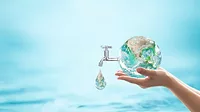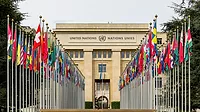Get Used to Drought, Says New Climate Report
The drought and dry conditions currently gripping half the country are a taste of things to come, according to a new report assessing the effects of global warming on water supplies in the West. The researchers say that conservation and efficient water use will be most important for future water supplies.
The drought and dry conditions currently gripping half the country are a taste of things to come, according to a new report by the Natural Resources Defense Council assessing the effects of global warming on water supplies in the West. The researchers say that as the hotter, drier weather already afflicting the region becomes the norm, officials responsible for keeping the taps flowing will need bold measures to improve conservation and efficiency. But drastic steps can be avoided if managers begin preparing now, the report says.
“Global warming will make it harder for farms and cities to find water,” says Barry Nelson, study co-author and co-director of NRDC’s western water project. “The latest global warming science is clear: Drought-like conditions are likely to increase. This means that conservation and water-use efficiency will become our most important sources of new water supply.”
Concern over droughts and global warming is increasing across the West. Over the past eight years, the Colorado River, which supplies water to parts of Arizona, California, Colorado, Nevada, New Mexico, Utah and Wyoming, has received just over half its average flow. Southern California is experiencing its driest year on record, and its Department of Water Resources predicts that every river in the southern Sierra Nevada will receive less than half of normal runoff this year.
Nelson says global warming can reduce water supply in several ways. In some regions, altered weather patterns may simply cause less precipitation, but the total amount is only half the story. It also matters whether precipitation falls as rain or snow. In most of the West, mountain snowpack is a natural reservoir that gradually supplies water when it’s needed during spring and summer. Warmer temperatures may cause winter precipitation to fall as rain, instead of snow, reducing this water supply. Finally, hotter summer temperatures will cause more water to evaporate out of watersheds, rivers and reservoirs. “Whether you’re turning on the tap in Los Angeles, irrigating a crop in Colorado, fishing for salmon on the Columbia River or rafting down the Grand Canyon, there will likely be less water,” notes Nelson. “Global warming will affect water supply for everyone in the West.”
The report analyzes the effects of global warming on a full range of water management tools and offers recommendations to help meet the challenge. Conservation tops the list of proven water supply solutions. For example, water use in the City of Los Angeles has remained steady for 30 years, despite dramatic population growth, thanks to investments such as low-flow showerheads and toilets. The city can save even more water through programs promoting drought-tolerant landscaping.
“Half of all urban water is used on lawns and landscapes, so there’s even more opportunity to create new supply through conservation,” says Nelson. “It’s common sense to choose plants that are naturally adapted to arid climates and to use cutting-edge irrigation technology. Drought tolerant landscapes are not only beautiful, they’re easier and less costly to maintain. And as a result of warming temperatures, landscape conservation is likely to be even more effective in the future.”
The report calls on regions to work much more closely together, developing cooperative solutions to meet their water needs and providing other important benefits. For example, ground water de-salters in California’s Chino basin produce water supplies, while cleaning up contaminated underground aquifers. Urban stormwater retention programs designed to reduce flooding and pollution also can provide water supplies.
The report highlights wastewater recycling as another promising solution. It suggests that traditional approaches – old-fashioned dams, diversions and ground water pumping – are likely to perform more poorly in the future. Although these were primary strategies for supplying water in the West during most of the past century, they will likely be less effective in a warmer, drier climate.
“Increasingly, traditional dams are no longer realistic or financially feasible solutions,” says Nelson. “The thousands of dams across the West have already captured most of the water. There are so few rivers left, and the cost of building dams is so high that the result is very expensive water. And global warming is likely to reduce the potential water supplies from new dams even further. Whether you examine water supply strategies from a business, environmental or global warming perspective, water conservation and recycling are going to be the smart investments in the future.”
The drought and dry conditions currently gripping half the country are a taste of things to come, according to a new report by the Natural Resources Defense Council assessing the effects of global warming on water supplies in the West. The researchers say that as the hotter, drier weather already afflicting the region becomes the norm, officials responsible for keeping the taps flowing will need bold measures to improve conservation and efficiency. But drastic steps can be avoided if managers begin preparing now, the report says.
“Global warming will make it harder for farms and cities to find water,” says Barry Nelson, study co-author and co-director of NRDC’s western water project. “The latest global warming science is clear: Drought-like conditions are likely to increase. This means that conservation and water-use efficiency will become our most important sources of new water supply.”
Concern over droughts and global warming is increasing across the West. Over the past eight years, the Colorado River, which supplies water to parts of Arizona, California, Colorado, Nevada, New Mexico, Utah and Wyoming, has received just over half its average flow. Southern California is experiencing its driest year on record, and its Department of Water Resources predicts that every river in the southern Sierra Nevada will receive less than half of normal runoff this year.
Nelson says global warming can reduce water supply in several ways. In some regions, altered weather patterns may simply cause less precipitation, but the total amount is only half the story. It also matters whether precipitation falls as rain or snow. In most of the West, mountain snowpack is a natural reservoir that gradually supplies water when it’s needed during spring and summer. Warmer temperatures may cause winter precipitation to fall as rain, instead of snow, reducing this water supply. Finally, hotter summer temperatures will cause more water to evaporate out of watersheds, rivers and reservoirs. “Whether you’re turning on the tap in Los Angeles, irrigating a crop in Colorado, fishing for salmon on the Columbia River or rafting down the Grand Canyon, there will likely be less water,” notes Nelson. “Global warming will affect water supply for everyone in the West.”
The report analyzes the effects of global warming on a full range of water management tools and offers recommendations to help meet the challenge. Conservation tops the list of proven water supply solutions. For example, water use in the City of Los Angeles has remained steady for 30 years, despite dramatic population growth, thanks to investments such as low-flow showerheads and toilets. The city can save even more water through programs promoting drought-tolerant landscaping.
“Half of all urban water is used on lawns and landscapes, so there’s even more opportunity to create new supply through conservation,” says Nelson. “It’s common sense to choose plants that are naturally adapted to arid climates and to use cutting-edge irrigation technology. Drought tolerant landscapes are not only beautiful, they’re easier and less costly to maintain. And as a result of warming temperatures, landscape conservation is likely to be even more effective in the future.”
The report calls on regions to work much more closely together, developing cooperative solutions to meet their water needs and providing other important benefits. For example, ground water de-salters in California’s Chino basin produce water supplies, while cleaning up contaminated underground aquifers. Urban stormwater retention programs designed to reduce flooding and pollution also can provide water supplies.
The report highlights wastewater recycling as another promising solution. It suggests that traditional approaches – old-fashioned dams, diversions and ground water pumping – are likely to perform more poorly in the future. Although these were primary strategies for supplying water in the West during most of the past century, they will likely be less effective in a warmer, drier climate.
“Increasingly, traditional dams are no longer realistic or financially feasible solutions,” says Nelson. “The thousands of dams across the West have already captured most of the water. There are so few rivers left, and the cost of building dams is so high that the result is very expensive water. And global warming is likely to reduce the potential water supplies from new dams even further. Whether you examine water supply strategies from a business, environmental or global warming perspective, water conservation and recycling are going to be the smart investments in the future.”
Looking for a reprint of this article?
From high-res PDFs to custom plaques, order your copy today!






